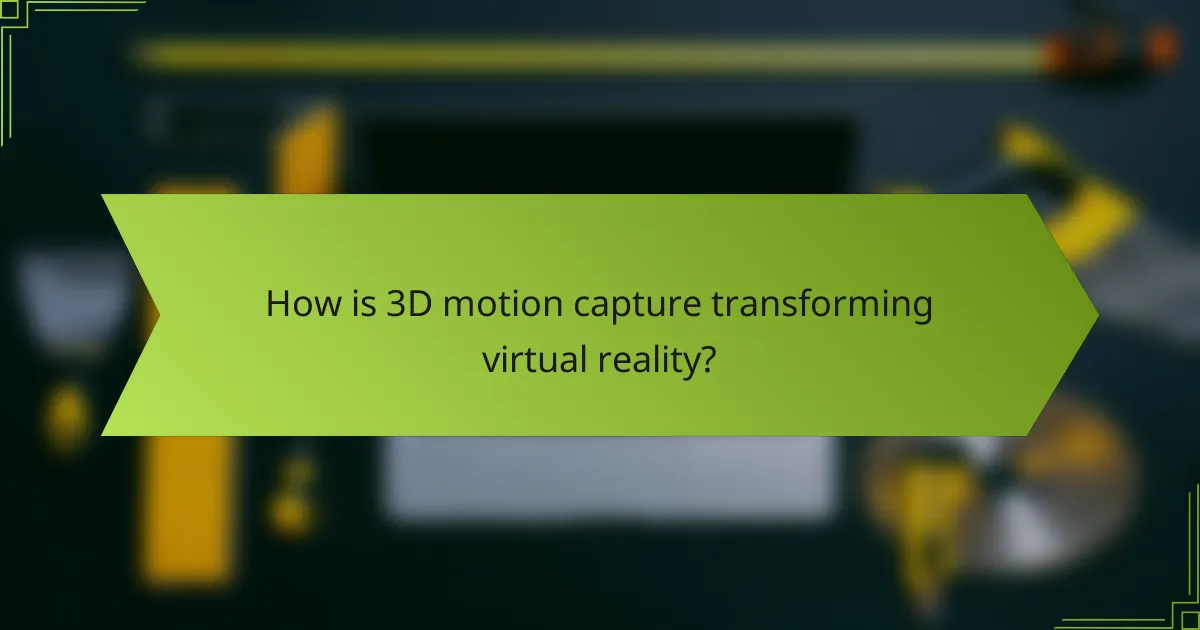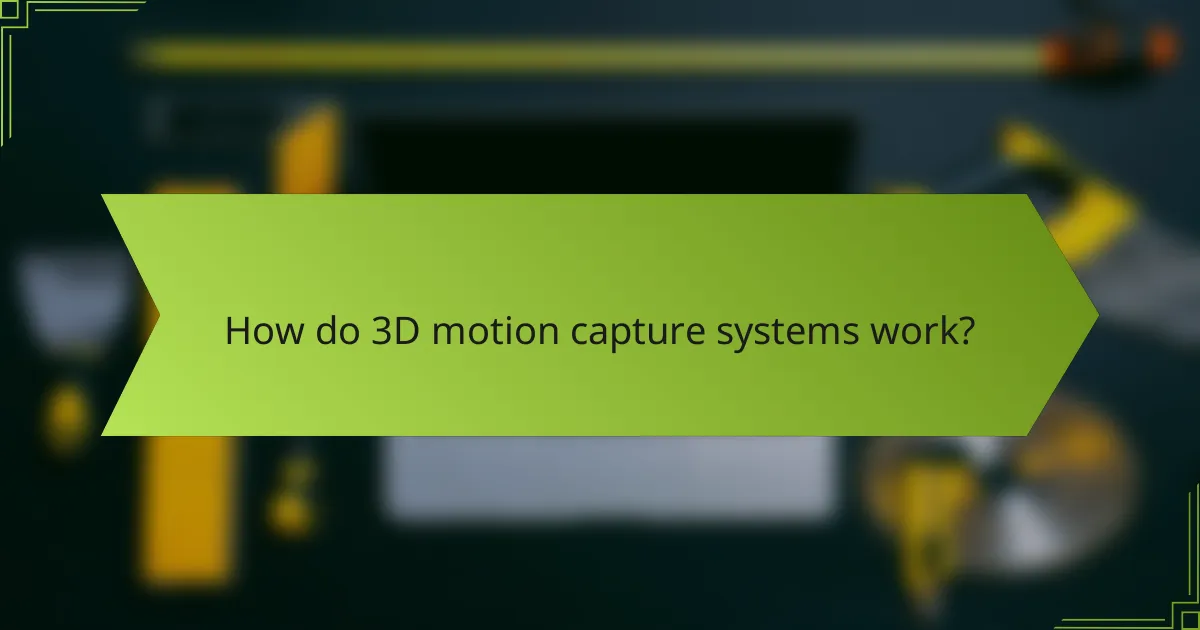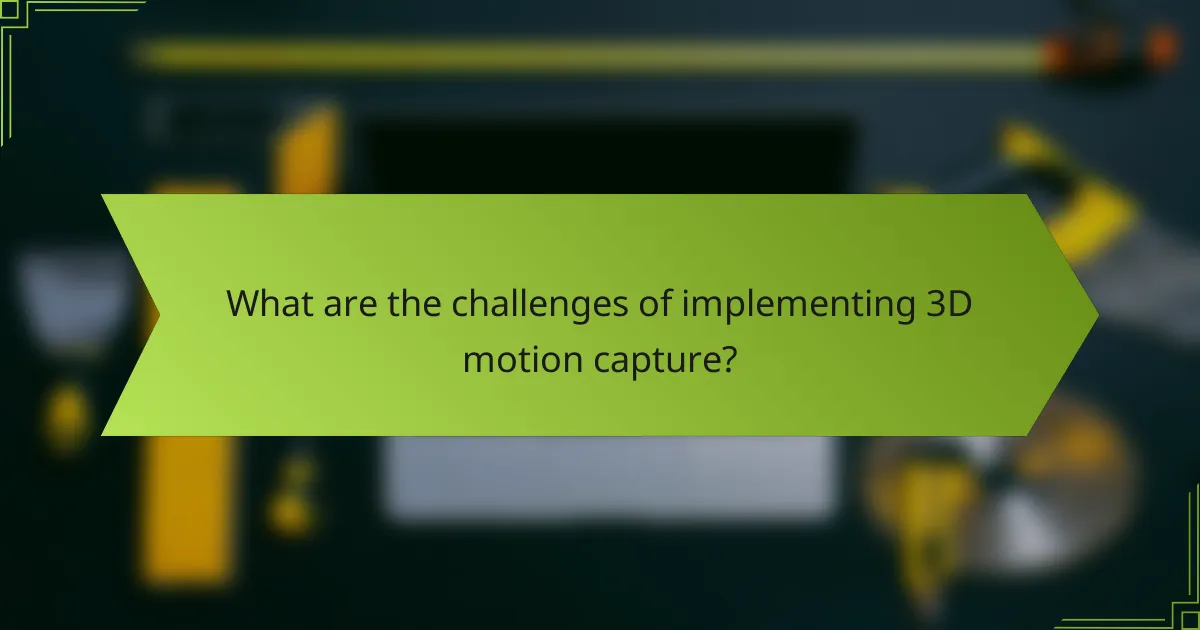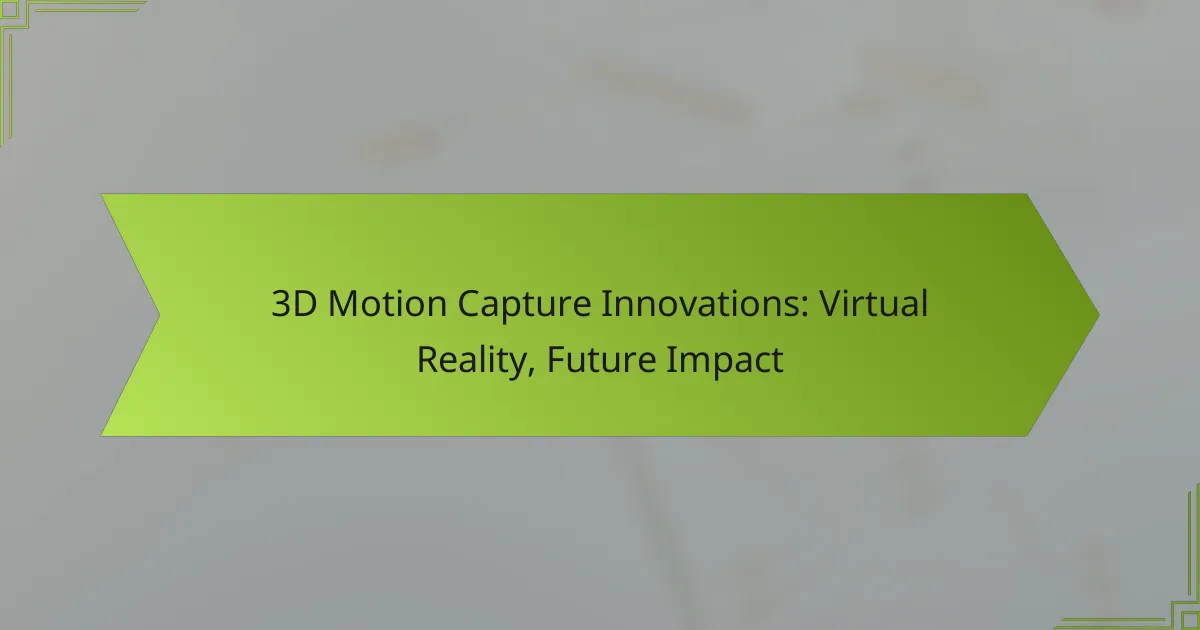3D motion capture is at the forefront of transforming virtual reality by delivering precise and realistic representations of human movement, significantly enhancing user immersion. Recent innovations in this technology, including advancements in optical systems and real-time data processing, are reshaping industries like gaming and film, enabling more engaging and lifelike experiences.

How is 3D motion capture transforming virtual reality?
3D motion capture is revolutionizing virtual reality (VR) by providing highly accurate and realistic representations of human movement, enhancing user immersion and interaction. This technology captures the nuances of physical actions, allowing for more engaging and lifelike experiences in various applications.
Enhanced realism in gaming
In gaming, 3D motion capture significantly boosts realism by translating players’ movements into the game environment. This technology allows characters to mimic real-life actions, creating a more immersive experience. For instance, players can perform complex maneuvers that are accurately reflected in-game, enhancing gameplay and emotional engagement.
Game developers often use motion capture to create fluid animations and lifelike interactions, which can lead to higher player satisfaction. The integration of this technology can also reduce the time needed for animation, allowing studios to focus on other creative aspects of game design.
Improved training simulations
3D motion capture is essential for training simulations across various fields, including healthcare, military, and aviation. By accurately replicating real-world scenarios, trainees can practice skills in a controlled environment, improving their performance and confidence. For example, medical professionals can rehearse surgical procedures using motion-captured data to refine their techniques.
These simulations can be tailored to specific needs, providing feedback on performance and allowing for iterative learning. Organizations benefit from reduced training costs and improved outcomes, as participants can engage in realistic scenarios without the risks associated with real-life practice.
Applications in film production
In film production, 3D motion capture enhances storytelling by enabling filmmakers to create realistic character movements and expressions. This technology allows actors to perform in a virtual space, capturing their performances for animated characters or special effects. Iconic films have utilized motion capture to bring fantastical creatures to life, blending live-action with digital artistry.
Moreover, motion capture can streamline the production process by reducing the need for extensive post-production animation. Filmmakers can achieve high-quality results more efficiently, allowing for greater creative freedom and innovation in visual storytelling.

What are the latest innovations in 3D motion capture technology?
The latest innovations in 3D motion capture technology include advancements in optical systems, improvements in inertial capture methods, and enhanced real-time data processing capabilities. These developments are transforming industries such as gaming, film, and virtual reality by providing more accurate and efficient ways to capture human movement.
Optical motion capture advancements
Recent advancements in optical motion capture technology focus on increasing accuracy and reducing setup time. New camera systems can capture movements with greater precision, often using higher frame rates and improved algorithms to track markers more effectively. This results in smoother animations and more realistic character movements.
Additionally, some systems now incorporate machine learning techniques to enhance marker detection and reduce occlusion issues. For example, using artificial intelligence can help fill in gaps when markers are obscured, ensuring a continuous capture of motion even in complex scenes.
Inertial motion capture systems
Inertial motion capture systems have gained popularity due to their portability and ease of use. These systems rely on accelerometers and gyroscopes to track body movements without the need for external cameras. This makes them ideal for on-location shoots or environments where traditional setups are impractical.
While inertial systems can be less accurate than optical systems, advancements in sensor technology have significantly improved their performance. Users should consider the trade-offs between mobility and precision when selecting a system, as inertial setups may require more post-processing to achieve desired accuracy.
Real-time data processing
Real-time data processing capabilities are crucial for applications in virtual reality and live performances. Innovations in software now allow for immediate feedback and adjustments during motion capture sessions, enabling creators to see results instantly. This reduces the time spent on post-production and enhances the overall workflow.
Moreover, some platforms now support cloud-based processing, allowing for collaborative projects where multiple users can access and edit motion data simultaneously. This feature is particularly beneficial for teams working across different locations, streamlining the production process and improving efficiency.

How do 3D motion capture systems work?
3D motion capture systems work by tracking the movement of objects or people in three-dimensional space using various technologies. These systems capture motion data, which can then be translated into digital animations or real-time interactions in virtual environments.
Sensor technology
Sensor technology is the backbone of 3D motion capture systems, utilizing devices like cameras, accelerometers, and gyroscopes to detect movement. Optical sensors, for instance, capture the position of reflective markers placed on the subject, while inertial sensors measure motion through acceleration and rotation.
Choosing the right sensor type depends on the application; optical systems are often preferred for high accuracy in controlled environments, while inertial systems are more versatile for outdoor or dynamic settings. Each type has its trade-offs in terms of cost, complexity, and data fidelity.
Data mapping techniques
Data mapping techniques convert raw motion data into usable formats for animation or analysis. This involves algorithms that interpret the captured data, aligning it with a digital skeleton or model to create realistic movements. Common methods include marker-based tracking and markerless techniques, each with unique advantages.
Marker-based tracking provides high precision but requires careful setup, while markerless systems offer greater flexibility and ease of use, albeit with potentially lower accuracy. Understanding these techniques helps in selecting the best approach for specific projects.
Software integration
Software integration is crucial for processing and utilizing motion capture data effectively. This involves using specialized software that can handle data input from various sensors, apply mapping techniques, and output the results in formats compatible with animation or gaming engines.
Popular software solutions include Autodesk MotionBuilder and Vicon Blade, which offer tools for editing and refining motion data. When choosing software, consider factors like compatibility with your existing systems, user interface, and support for real-time applications.

What industries benefit from 3D motion capture?
3D motion capture technology significantly enhances various industries by providing precise tracking of human movement. Key sectors include entertainment, healthcare, and sports analytics, each leveraging this innovation to improve outcomes and experiences.
Entertainment and gaming
In the entertainment and gaming industries, 3D motion capture is essential for creating realistic animations and immersive experiences. By capturing the nuances of human movement, developers can produce lifelike characters that enhance storytelling and gameplay.
For example, major game studios often use motion capture to animate characters based on real actors’ performances, resulting in more engaging interactions. This technology can reduce production time and costs while improving the overall quality of the final product.
Healthcare and rehabilitation
3D motion capture is transforming healthcare, particularly in rehabilitation and physical therapy. By analyzing patients’ movements, therapists can tailor treatment plans to individual needs, track progress, and adjust exercises accordingly.
In practice, motion capture systems can identify movement deficiencies and provide visual feedback, helping patients understand their progress. This technology is increasingly used in clinics and hospitals, making rehabilitation more effective and personalized.
Sports analytics
In sports analytics, 3D motion capture offers valuable insights into athletes’ performance and biomechanics. Coaches and trainers can use this data to optimize training regimens, improve techniques, and reduce injury risks.
For instance, motion capture can analyze an athlete’s running form or swing mechanics, allowing for precise adjustments that enhance performance. Many professional sports teams now integrate this technology into their training programs to gain a competitive edge.

What are the challenges of implementing 3D motion capture?
Implementing 3D motion capture presents several challenges, including high costs, complex setup requirements, and data accuracy issues. These factors can significantly impact the feasibility and effectiveness of motion capture systems in various applications.
High costs of equipment
The initial investment for 3D motion capture equipment can be substantial, often ranging from several thousand to tens of thousands of dollars. This includes not only the cameras and sensors but also the necessary software and hardware for processing the data.
Organizations must weigh the costs against their budget and the potential return on investment. For smaller studios or independent developers, exploring rental options or lower-cost alternatives may be necessary to mitigate financial strain.
Complex setup requirements
Setting up a 3D motion capture system can be intricate, requiring careful calibration and positioning of cameras and sensors. This process often demands a dedicated space free from obstructions, which can complicate logistics in smaller environments.
Additionally, the setup may require technical expertise to ensure that the system functions correctly. Investing in training for staff or hiring specialists can help streamline the installation and operational phases.
Data accuracy issues
Data accuracy is crucial for effective motion capture, yet it can be affected by various factors such as lighting conditions, occlusions, and sensor limitations. Inconsistent data can lead to poor animation quality and misrepresentation of movements.
To enhance accuracy, regular calibration and maintenance of the equipment are essential. Implementing redundancy in sensors and using advanced algorithms for data processing can also help mitigate accuracy-related challenges.
